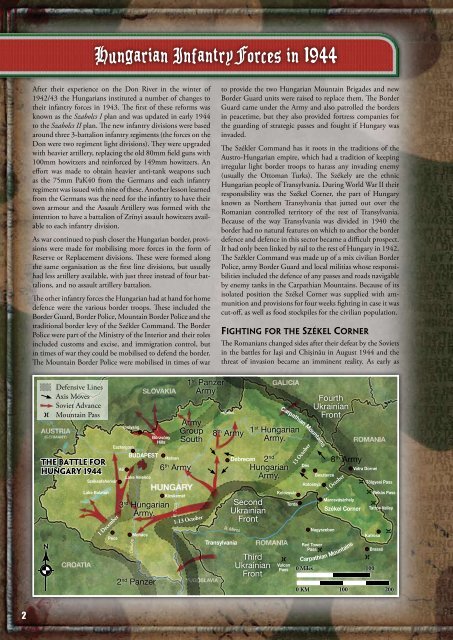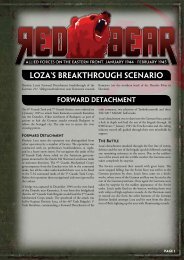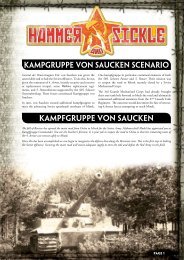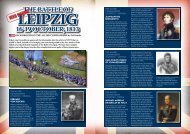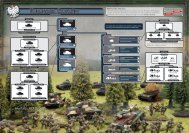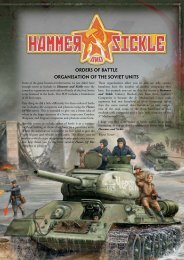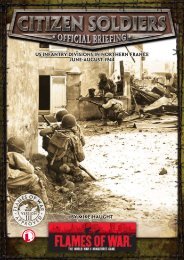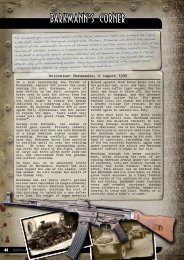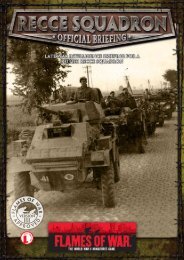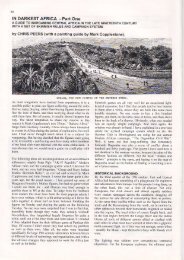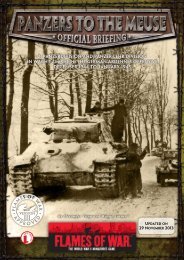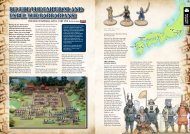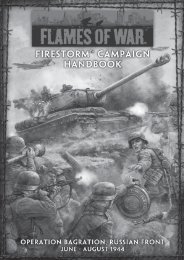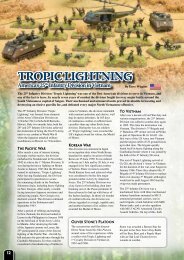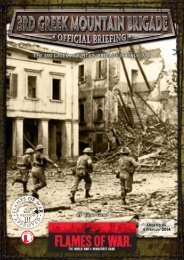Hungarian Infantry (PDF)... - Flames of War
Hungarian Infantry (PDF)... - Flames of War
Hungarian Infantry (PDF)... - Flames of War
Create successful ePaper yourself
Turn your PDF publications into a flip-book with our unique Google optimized e-Paper software.
Defensive Lines<br />
Axis Moves<br />
Soviet Advance<br />
Mountain Pass<br />
<strong>Hungarian</strong> <strong>Infantry</strong> Forces in 1944<br />
After their experience on the Don River in the winter <strong>of</strong><br />
1942/43 the <strong>Hungarian</strong>s instituted a number <strong>of</strong> changes to<br />
their infantry forces in 1943. The first <strong>of</strong> these reforms was<br />
known as the Szabolcs I plan and was updated in early 1944<br />
to the Szabolcs II plan. The new infantry divisions were based<br />
around three 3-battalion infantry regiments (the forces on the<br />
Don were two regiment light divisions). They were upgraded<br />
with heavier artillery, replacing the old 80mm field guns with<br />
100mm howitzers and reinforced by 149mm howitzers. An<br />
effort was made to obtain heavier anti-tank weapons such<br />
as the 75mm PaK40 from the Germans and each infantry<br />
regiment was issued with nine <strong>of</strong> these. Another lesson learned<br />
from the Germans was the need for the infantry to have their<br />
own armour and the Assault Artillery was formed with the<br />
intention to have a battalion <strong>of</strong> Zrínyi assault howitzers available<br />
to each infantry division.<br />
As war continued to push closer the <strong>Hungarian</strong> border, provisions<br />
were made for mobilising more forces in the form <strong>of</strong><br />
Reserve or Replacement divisions. These were formed along<br />
the same organisation as the first line divisions, but usually<br />
had less artillery available, with just three instead <strong>of</strong> four battalions,<br />
and no assault artillery battalion.<br />
The other infantry forces the <strong>Hungarian</strong> had at hand for home<br />
defence were the various border troops. These included the<br />
Border Guard, Border Police, Mountain Border Police and the<br />
traditional border levy <strong>of</strong> the Székler Command. The Border<br />
Police were part <strong>of</strong> the Ministry <strong>of</strong> the Interior and their roles<br />
included customs and excise, and immigration control, but<br />
in times <strong>of</strong> war they could be mobilised to defend the border.<br />
The Mountain Border Police were mobilised in times <strong>of</strong> war<br />
The BaTTle For<br />
hungary 1944<br />
N<br />
Székesfehérvár<br />
Lake Balaton<br />
1 December<br />
Pécs<br />
Esztergom<br />
Vál<br />
Ipolyság<br />
BUDAPEST<br />
Lake Velence<br />
3 rd <strong>Hungarian</strong><br />
Army.<br />
R. Danube<br />
Mohács<br />
2 nd Panzer<br />
Börzsöny<br />
Hills<br />
Hatvan<br />
6 th Army<br />
Kicskemét<br />
R. Tisza<br />
1 st Panzer<br />
Army<br />
Army<br />
Group<br />
South<br />
1-13 October<br />
to provide the two <strong>Hungarian</strong> Mountain Brigades and new<br />
Border Guard units were raised to replace them. The Border<br />
Guard came under the Army and also patrolled the borders<br />
in peacetime, but they also provided fortress companies for<br />
the guarding <strong>of</strong> strategic passes and fought if Hungary was<br />
invaded.<br />
The Székler Command has it roots in the traditions <strong>of</strong> the<br />
Austro-<strong>Hungarian</strong> empire, which had a tradition <strong>of</strong> keeping<br />
irregular light border troops to harass any invading enemy<br />
(usually the Ottoman Turks). The Székely are the ethnic<br />
<strong>Hungarian</strong> people <strong>of</strong> Transylvania. During World <strong>War</strong> II their<br />
responsibility was the Székel Corner, the part <strong>of</strong> Hungary<br />
known as Northern Transylvania that jutted out over the<br />
Romanian controlled territory <strong>of</strong> the rest <strong>of</strong> Transylvania.<br />
Because <strong>of</strong> the way Transylvania was divided in 1940 the<br />
border had no natural features on which to anchor the border<br />
defence and defence in this sector became a difficult prospect.<br />
It had only been linked by rail to the rest <strong>of</strong> Hungary in 1942.<br />
The Székler Command was made up <strong>of</strong> a mix civilian Border<br />
Police, army Border Guard and local militias whose responsibilities<br />
included the defence <strong>of</strong> any passes and roads navigable<br />
by enemy tanks in the Carpathian Mountains. Because <strong>of</strong> its<br />
isolated position the Székel Corner was supplied with ammunition<br />
and provisions for four weeks fighting in case it was<br />
cut-<strong>of</strong>f, as well as food stockpiles for the civilian population.<br />
Fighting For the Székel Corner<br />
The Romanians changed sides after their defeat by the Soviets<br />
in the battles for Iaşi and Chişinău in August 1944 and the<br />
threat <strong>of</strong> invasion became an imminent reality. As early as<br />
8 th Army<br />
Second<br />
Ukrainian<br />
Front<br />
R. Maros<br />
Transylvania<br />
Debrecen<br />
1 st <strong>Hungarian</strong><br />
Army.<br />
2 nd<br />
<strong>Hungarian</strong><br />
Army.<br />
Third<br />
Ukrainian<br />
Front<br />
Carpathian Mountains<br />
Kolozsvár<br />
Vulcan<br />
Pass<br />
Torda<br />
13 October<br />
Dés<br />
Ratosnya<br />
Fourth<br />
Ukrainian<br />
Front<br />
Nagyszeben<br />
Red Tower<br />
Pass<br />
8 th Army<br />
1 October<br />
Székel Corner<br />
Carpathian Mountains<br />
0 Miles<br />
0 KM<br />
Beszterce<br />
Marosvásárhely<br />
Vatra Dornei<br />
Tölgyesi Pass<br />
Békás Pass<br />
Tatros Valley<br />
Katrosa<br />
Brassó<br />
100<br />
100 200


